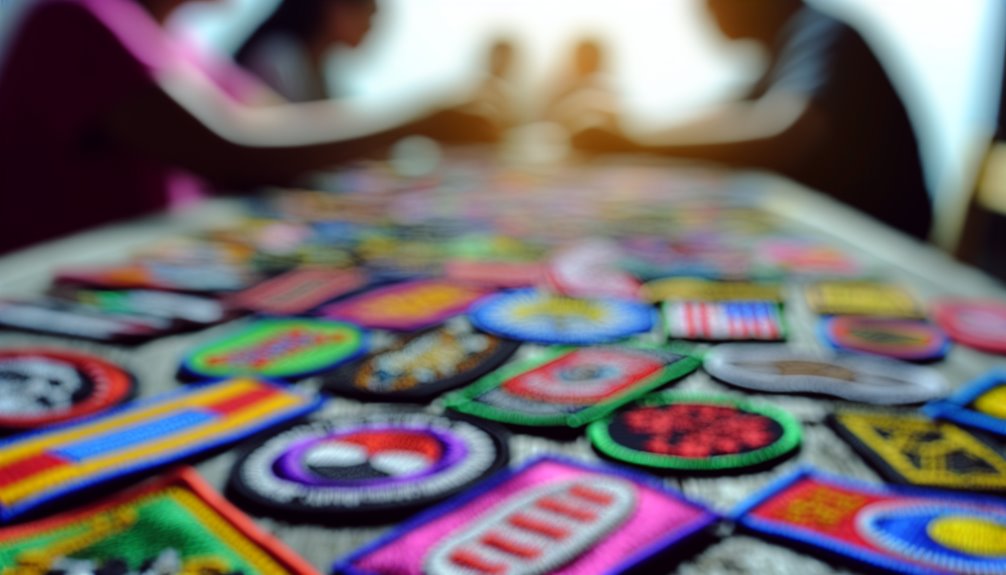Raised stitched 3D puff embroidery patches prevail for five key reasons. Their tactile, three-dimensional quality creates a sensory experience impossible with flat printing. Superior durability enables them to withstand years of washing and wear. Their prestigious aesthetic cannot be replicated digitally, signaling quality and authenticity. Versatility allows application across fashion and functional settings, from youth apparel to military insignias. Finally, their rich heritage connects to centuries of global craftsmanship traditions. The full story of embroidery’s dominance extends beyond these surface-level advantages.
Unmatched Tactile Appeal & Dimensional Quality
The dimension of raised stitched embroidery patches creates an immediate sensory experience unlike any other embellishment method. When fingers trace the elevated threads, they encounter a textural contrast that flat printing simply cannot replicate. This tactile quality engages users beyond mere visual appreciation, creating a multi-sensory connection to the design.
The dimensional aspect serves practical purposes as well. The height variation between background and foreground elements creates natural shadows that enhance visibility from various angles. This depth perception allows designs to remain recognizable even in less-than-ideal lighting conditions.
Additionally, the layered construction provides durability advantages, as raised elements can withstand friction and wear that might quickly degrade flat alternatives. This combination of sensory appeal and practical benefits explains why raised stitching continues to dominate the embroidery landscape despite technological alternatives.
Superior Durability and Longevity
While most decorative embellishments deteriorate with regular washing and wear, raised stitched embroidery patches maintain their structural integrity through countless cycles of use. The combination of high-quality material selection and advanced stitching techniques guarantees these patches withstand daily stresses that would compromise lesser adornments.
| Durability Factor | Standard Patches | Raised Stitched Patches |
|---|---|---|
| Wash Resistance | Moderate | Excellent |
| UV Stability | Low | High |
| Edge Fraying | Common | Rare |
| Color Retention | 6-12 months | 3-5 years |
| Physical Stress | Easily Damaged | Highly Resistant |
Users should understand that this exceptional longevity stems from the densely packed thread counts and reinforced backing materials. The three-dimensional structure actually distributes wear more evenly across the surface, preventing concentrated damage that typically leads to premature failure in flat embroidery.
Prestigious Aesthetic That Cannot Be Digitally Replicated
Despite advances in digital printing technology, raised stitched embroidery patches possess a distinctive dimensional quality that remains impossible to replicate through digital means. The tactile nature of thread layering creates depth and texture that flat printing simply cannot achieve, giving these patches an inherent prestige.
Organizations seeking to establish a strong visual identity understand that embroidered patches communicate permanence and authenticity. The physical elevation of design elements represents a tangible form of artistic expression that catches both light and attention differently from any two-dimensional alternative.
This craft-based approach signals quality and tradition, important considerations when representing established institutions or premium brands. While digital methods may offer speed and convenience, they consistently fall short of delivering the sophisticated dimensional characteristics that make raised embroidery instantly recognizable as superior craftsmanship.
Versatility Across Fashion and Functional Applications
Raised stitched embroidery patches extend far beyond mere decorative elements, finding purpose across countless fashion and functional contexts. Their dimensional quality enables them to serve as striking fashion statements on denim jackets, backpacks, and haute couture pieces alike, drawing attention while expressing individuality.
This adaptability crosses demographic boundaries, appealing to both youth culture and established professional settings.
Beyond aesthetics, these patches provide functional enhancements for various industries. Military and service organizations utilize them for rank identification and unit cohesion, while outdoor brands incorporate them as reinforcement points on high-stress areas of gear.
Their durability guarantees they remain intact through repeated washing and environmental exposure, making them practical choices for workwear and specialized equipment where both identification and longevity matter considerably.
Rich Heritage and Timeless Craftsmanship
Although modern machinery has streamlined some production processes, the art of raised stitched embroidery patches traces its lineage through centuries of meticulous handcraft and cultural significance.
These emblems carry historical significance dating back to ancient civilizations where artisans developed traditional techniques that continue to influence contemporary designs.
- Military insignias from the 18th century established standards for dimensional embroidery that remain relevant today.
- Asian cultural traditions, particularly from China and Japan, contributed intricate layering methods still used by modern craftspeople.
- European guild systems formalized embroidery as a respected craft with strict quality requirements.
- Indigenous textile traditions worldwide incorporated raised stitching to convey status and tribal affiliation.
This enduring craftsmanship represents more than decoration—it connects wearers to a continuous thread of human expression spanning generations.
Conclusion
Like the timeless tapestry of human craftsmanship, raised stitched embroidery patches stand as sentinels against modern disposability. Their dimensional appeal, remarkable durability, and prestigious aesthetic cannot be matched by digital alternatives. While fashion trends may shift like desert sands, these patches remain anchored in heritage and versatility. Students of design should recognize this reality: in a world of fleeting impressions, true craftsmanship—like these textured emblems—always prevails.

